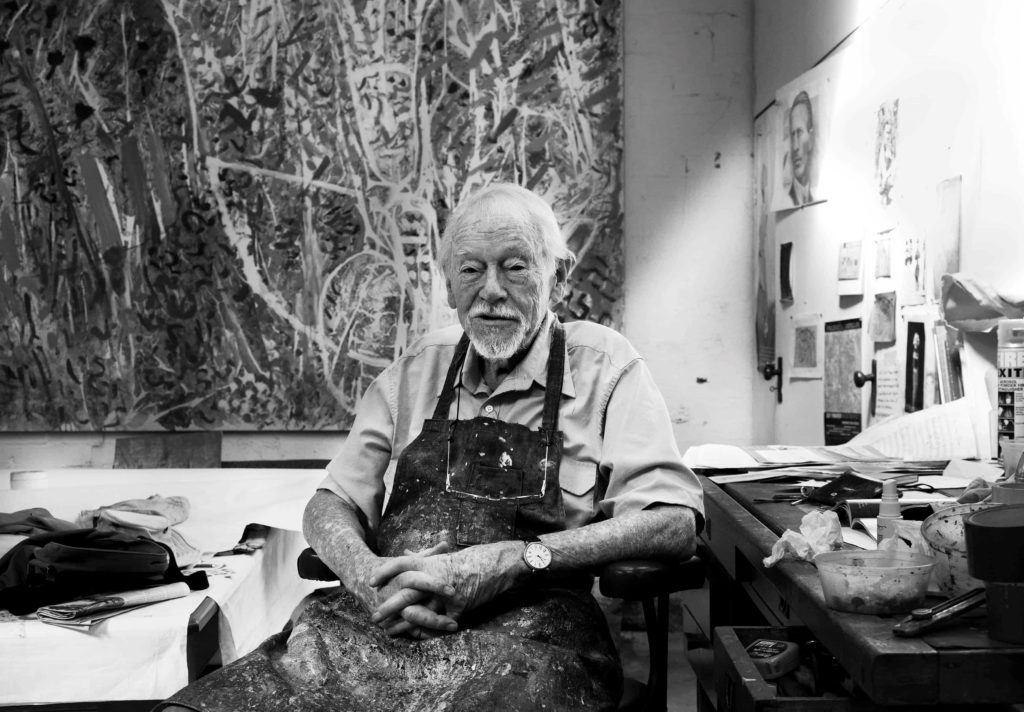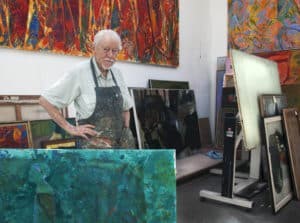Matthew Smith March 21, 2019©
Success – in the monetary sense – hasn’t been a major priority for Guy Warren, the great Australian artist who, at 98 years of age, is attracting the kind of notoriety that’s now bringing more commercial spoils his way.

Warren had an exhibition in February with the commercial gallery he recently joined – King Street Gallery, on William Street in Sydney’s inner suburbs – where hundreds of people turned up on opening night to sip Champagne, and where a generous number of Warren’s artworks were sold.
“It’s really beginning to happen for me,” Warren says, laughing wryly at the phrase that would make more sense coming out of the mouth of a much younger up-and-coming artist.
Warren is a serious artist, he has been all his life. His quizzical take on landscapes and the human form is born from his deep personal experience with Australia, which he has gained over close to a century of observing the country’s culture and unique expanses, from within, and from afar during stints living and travelling abroad.
Had the combination of “good genes and good luck” – the attributes Warren humbly credits with his long and happy life – not fallen in his lap, he might not have felt as financially prepared when he was approaching a more traditional retirement age as he does now. Demand for his works has grown in recent decades, with critics and amongst mainstream art investors, who perhaps first came to his work after he won the famous Archibald Prize in 1985 at the ripe old age of 64 with his work Flugelman with Wingman.

Warren never made decisions in his younger years to feather his nest in retirement. He recalls quitting a “bloody good job” as an art director at a major magazine publisher when he was in London, where he lived for eight years – two days before his second child was born.
“I wanted to be a painter, I wanted to paint,” he says. “I felt that if I waited another fortnight until after [his son] was born, I wouldn’t have the courage to leave. I think it was the best thing I did.”
It’s possible his commitment to take risks and follow his heart, rather than what a career counsellor or perhaps a financial adviser might deem a more sensible path, is part of the formula for Warren’s secret to living longer, though he won’t be held to this idea.
In amidst his life as a full-time professional artist, Warren has worked as an art director in magazine publishing, briefly worked in advertising and as a visual art designer. He has also been a lecturer and teacher in art and art history in prominent Australian universities and colleges.
It was in the 1970s, while he was a lecturer at the University of Sydney, when “some bloke” said he had to join a fund to help him save for retirement.
Now, much later in life, Warren says he’s done pretty well. “I’ve saved enough to pass on to the kids a reasonable amount, and I have a house of my own,” he says.
The financial comfort, it seems, has come thanks mostly to the success he’s enjoyed long after most people’s earning years are behind them.
Warren hasn’t given up on feeding his passion for travel and adventure, despite his senior years – far from it. “I was up at Alice Springs this time last year with a group of artists and they’re going again this year and trying to persuade me to go with them,” he says. “I go for the joy of being in the landscape and drawing and painting.
It’s not always about sitting on a hard rock and painting, I like to bring back materials and thoughts and work with ideas back in the studio.”
The retirement system wasn’t set up with Warren in mind, but in the future, there will be many more people who, like him, live and are active well beyond their 80s.

AGE BRACKET CREEP
When the Keating Labor government introduced superannuation 33 years ago, the retirement age was 65 and people weren’t expected to live past 85 years old.
Three decades later, people live between three and five years longer and people like Warren are enjoying life well into their 90s.
What’s not yet clear is how much of an economic impact the retirement system’s current setting will have on society and on the twilight years of individuals who live so long.
In the late 1970s, when Warren was lecturing at Sydney College of the Arts, just 9 per cent of the Australian population was over the age of 65. In 2017, 15 per cent of the population was over 65 years old and in another 40 years, 30 per cent of the population will be older than the age traditionally benchmarked for retirement, Australian Bureau of Statistics data shows.
Meanwhile, more than 90 per cent of member accounts in superannuation are in the accumulation phase, with the remaining 10 per cent in retirement but the retirement category accounts for more than a third of the system’s assets, APRA statistics from 2017 show.

“The significance of the retirement phase will only grow as the system continues to mature,” wrote Karen Chester, who was deputy chair of the Productivity Commission when she penned its final report, which published in January.
One-third of Australians aged 65 years and over rely on government pensions and allowances for more than half of their income, and about one-fifth of retirees in the super system rely on government payments for less than 1 per cent of their income, ABS statistics show.
By one projection, assets in the retirement phase may grow from about $400 billion today to more than $1.5 trillion by 2035, Chester noted, citing Deloitte figures.
NOT FIT FOR PURPOSE
The man responsible for implementing the current retirement savings system, former prime minister Paul Keating, is also the most vocal advocate for changing the superannuation to better fit the cohort of retirees expected to live longer and demand a better lifestyle for longer in retirement.
Keating proposes a national insurance scheme, in which a levy akin to a Medicare payment kicks in for people who live beyond 85, providing income support for aged-care accommodation and healthcare costs.
He cites the challenges retirees will likely face trying to bolster their savings or even just keeping up with inflation in a world where interest rates will most likely remain low and expected investment returns may need to be revised down.
“For many people, their pool of money will run out about 85, maybe stretch to 90,” Keating told ABC’s 7.30 late last year. “Once you get beyond that, there’s nothing to support you.
“When I introduced superannuation 32 years ago, people retired at 65 and they died at 83 or 85… People now live into their late 80s and the super pool isn’t large enough to maintain the sort of retirement we wish for them.”
“The truth is, age pension costs are reducing as a percentage of GDP and this will continue,” says Michael Rice, founder and director of actuarial and consulting firm Rice Warner. “The super system is working because it’s getting people off the pension.”
When it comes to supporting people, who might be near or approaching retirement age in reinventing themselves, so they have a better chance of making an income to supplement their savings, Rice says society has a role to play.
PEOPLE ARE RESILIENT
“At the moment, you have a bit of a problem where people are losing their job at 50 years old and not getting another one,” Rice says. “People are resilient, and they adjust, I just don’t think things are as bleak as people think. If anything, people need to learn to be less conservative – the numbers show that one-third of the people on the full age pension end up saving money.”
Rice Warner’s modelling shows that, over time, many people will increasingly self-fund their retirement and the proportion of the population receiving the pension will fall. By 2038, only 57 per cent of the eligible population will receive any age pension, with 29 per cent on the full pension and 27.5 per cent receiving a part pension.
Rice notes that expenditure dips as people get into their 70s because they become sedentary and spend less. However, it’s also widely known retirees will spend four times as much on medical expenses during retirement as they have during their entire lives before retirement.
The biggest curve ball for those modelling the superannuation system and for those who are advising retirees in the future will most likely come from the changing nature of work and labour markets, the Productivity Commission notes in its commentary.
Warren’s experience with retirement planning was limited and sporadic at best, mostly because his tenures and employment were fit in around his career as a self-employed artist.
With the way technology is evolving, giving rise to multiple employers aided by the “gig economy”, it’s likely the future workforce will go down more of a Warren path.
About one in every 12 workers change their employer every year, and when they do, there appears to be a higher tendency than in the past for them to change industry or occupation, the PC report highlights.
Increasing shifts of people between businesses, occupations and industries, propelled by digital disruption, will mean people face greater uncertainty about their future retirement balances, which will require more retirement income planning and engagement with super professionals, the PC report highlights. Further, fewer people will be able to own their own dwellings, which means retirement asset portfolios will look quite different from today, with a reduced weighting on equity in people’s homes, the report notes.
The conclusions in Chester’s final report point to the need for changes to the superannuation system to consider individual and employee needs over the collective needs of employers.
KEEP YOUNG FRIENDS
Warren’s best advice to his cohort for enjoying the retirement years is to keep young friends and to keep communicating with people.
“Keep young friends around you because if you only communicate with your own age group, they’ll die off and you’ll have no one to talk to,” he says.
Communicating is essential to living a fulfilled life, he adds.
Warren describes his art as a way of communicating on a visual scale. He also has taught and lectured all his life, which he says enables him to communicate and keep young friends.
“I suspect our attitude towards art is a product of the tough nature of our beginnings,” Warren says. “There wasn’t time for art and creativity to be taken seriously, people were grubbing for a living, doing what they could to come out of the mess they were in, trying to survive in an alien land. I think it was probably a pretty tough struggle.”
Warren left school when he was 14 because, in the middle of the Great Depression, “the family was broke and another quid or 2 per week was a very useful thing to have”. He also fought in the Second World War; it was an ex-service program that brought him to the National Art School in Sydney, where three years of art training “gave me the foundation for what I’ve done ever since”.
Life gets more difficult as you get older, Warren admits.
“The body doesn’t work as well as it used to and it’s more difficult to do many of the things you took for granted,” he says. “I think this is frustrating for a lot of people as they get older, but I think it’s important to have something you love and to keep doing it.”
Smith is the editor of Professional Planner’s print and digital platforms. He is an experienced financial journalist, editor and multimedia producer who has held senior editorial positions both in mainstream press and trade media.